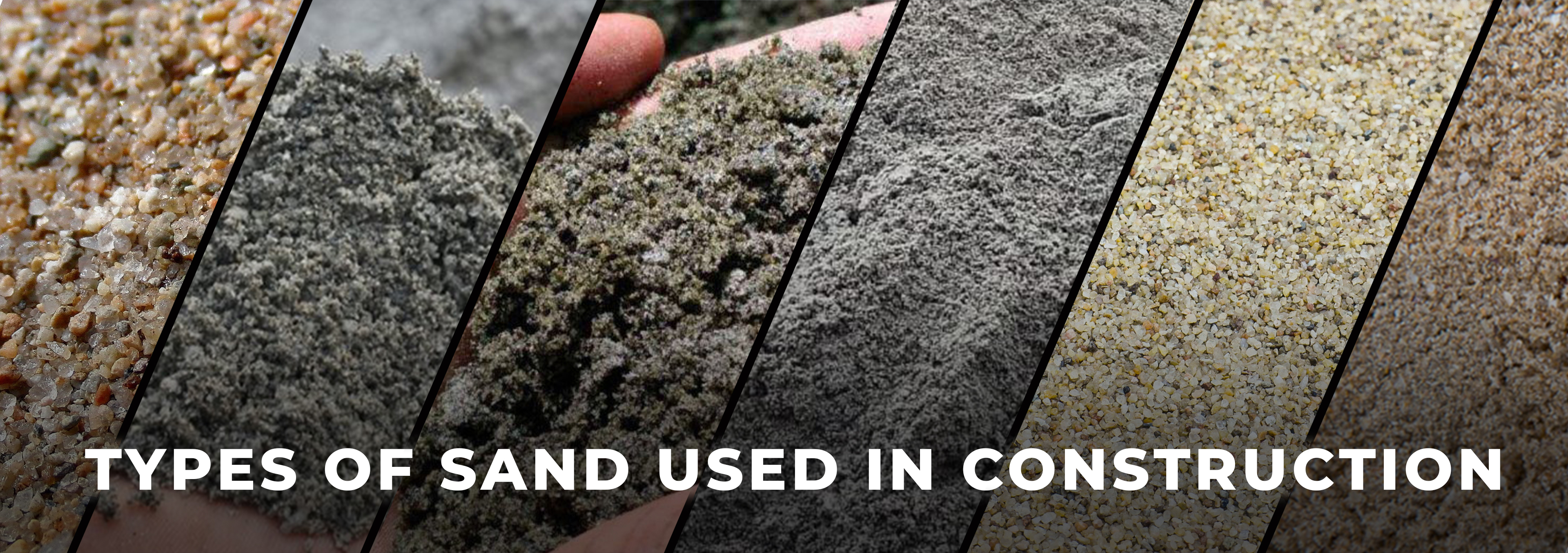
When it comes to building construction, sand plays a very important role as it directly impacts the strength of the home. There are various types of construction sand, so selecting the suitable sand for construction is essential. Knowing the properties of construction sand is necessary for making informed decisions. This write-up will help you select the right kind of construction sand for your home by giving insights into the various types of sand used for construction.
What is Construction Sand?
Sand is a granular material composed of small and fine grains found in natural settings after the defragmentation of rocks, including various materials and minerals. Its particle size ranges from 0.06mm to 2mm.
Types of Sand Used in Construction

There are different types of sand for construction, here are a few listed below:
• River Sand
• M Sand
• C Sand (grade)
• C Sand (ungraded)
• Plastering Sand
• Dust
• Single-washed sand
• Double-washed sand
• Triple-washed sand
• Air-washed sand
• Oil-washed sand
• Water-washed sand
• M sand for plastering
Let's discuss the 4 types of sand that are commonly used in construction in the following section of the article.
Thinking which sand is best for construction, are you in a hurry? If you don't have time, click here to contact us for a more detailed explanation.
RIVER SAND
webp_32582.webp)
River sand was the most commonly used sand for construction until late 20’s, but the usage of river sand in construction has been banned due to the need for more naturally occurring river sand.
Particle Size and Shape: Due to erosion caused in the river, the river sand particles are often well-rounded. The particle size ranges from 0.1 to 0.5 mm.
Texture: River sand has a smooth texture. The smooth texture of the River Sand is a key feature that makes it workable and simple to combine with other materials.
Gradation: River sand naturally varies in particle gradation.
CONCRETE SAND (C Sand)
webp_43442.webp)
Concrete sand, also known as c-sand, is made from crushed quarried stone to a size that passes through a sieve of 0.15 mm to 4.75 mm.
Concrete sand is the most preferred sand for construction because of its bonding with concrete, and it provides strength and durability to buildings compared to other sands.
Particle Size: The particle size of concrete sand is 0.15 mm to 4.75 mm.
Strength and Stability: When employed in the right quantities, the bigger particles of coarse sand provide construction materials with strength and stability.
Water Permeability: Because coarse sand includes bigger particles, it drains better and is thus appropriate for applications where water flow is sought.
Grading: Balanced distribution of particle sizes
Click on the below link to get a free C-sand bag sample and a free demo.
USES OF CONCRETE SAND IN CONSTRUCTION -
According to IS code 383:2016.
Concrete sand is the most versatile sand used in construction and has various uses.
C sand is also used in concrete mixes along with aggregates, cement, and water to enhance the strength and durability of the infrastructure.
M SAND
webp_71724.webp)
M Sand, also known as manufactured sand, is an artificially produced sand used for construction purposes.
Particle Size: M sand is manufactured by crushing stones and filtered under various standard tests. The particles of M sand are uniform in size.
Strength: M sand particles' angular and cubical shapes boost their interlocking capabilities with other mixture components, making for stronger concrete mixtures.
Even though M Sand is widely used for construction, it is not preferred for construction. Read this article to know why.
PLASTERING SAND (P Sand)
webp_58597.webp)
Plastering sand or P-sand is the sand that is specifically manufactured for the purpose of plastering. Plastering sand is generally white-grey in color. Sand has unique properties that make it appropriate for plastering and rendering activities -
Texture: Plastering sand has a smooth texture, uniform particles, and small particles, which make it simple to work with while ensuring a smooth process of plastering and rendering projects.
Grading: The P sand particles are well-graded, assuring consistency in the mixture and reducing the possibility of air spaces, voids, or weak places in the plastering layer.
Silt Content: P sand is filtered of all impurities and often is filtered of extra silt, clay, or other impurities, which would otherwise hinder the plaster from adhering to surfaces.
Uses Of P Sand
P sand is most specifically manufactured for plastering purposes. The particles are made free of silt and other particles, as their uniform particular nature provides a smooth layer of protection to the walls to protect them from external conditions.
Click on the below link to get free P Sand bag sample and free demo.
Now that we have looked into the 4 most used sands in construction in India, the question arises as to where to purchase the right quality of sand for construction near me.
Alpha C Sand and Alpha P Sand
webp_41118.webp)
Alpha Sand provides the best concrete sand and plastering sand for construction. Alpha C Sand is the best C Sand that is ideal for construction because of the gradation of sand and the well-balanced distribution of different particle sizes. The absence of silt in Alpha C sand ensures reduced shrinkage and, thus, reduces the chances of cracking. It increases the durability of the structure.
Alpha P sand ensures smooth finishing and provides safety and stability to the walls as alpha P Sand is free of silt and other impurities. At Alpha Sand, you will surely receive the best-quality products at the best prices.
Click on the below link to get free Sand bag sample and free demo.
Conclusion:
Sand has various uses in construction, and we discussed the key characteristics and properties of the different kinds of sands used in construction, including C sand, concrete sand; river River sand, or manufactured sand; and P sand, or plastering sand. Each has its specific uses and is used as raw materials used in mixtures to prepare concrete, cement, and other mixtures. So the next time you look for the most suitable sand for your project, you are well informed of your choices. Happy construction!
Frequently Asked Questions
1. Which is the best sand for construction?
Alpha Sand is the best sand for construction because of its exceptional characteristics and properties.
2. Which type of sand is used in construction?
Each step of construction requires a different type of sand. Make sure to check with your builder before you choose your project.
3. What are the 5 types of sand most commonly used in construction?
The most used sands for construction in India are: dust, M sand, C sand, river sand, and P sand.